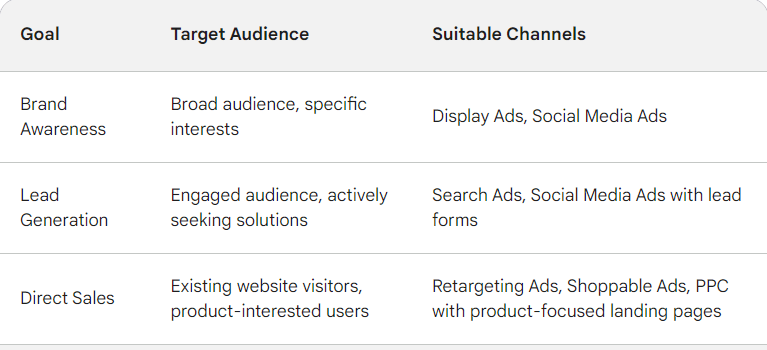Unraveling the Mystery: PPC vs. Paid Marketing
Intoduction:
The digital advertising landscape is brimming with buzzwords and acronyms, and “PPC” and “Paid Marketing” are two that often cause confusion. While they might seem interchangeable at first glance, there are key distinctions between these marketing approaches. In this blog post, we’ll act as your decoder ring, breaking down the definitions and highlighting the crucial differences to empower your online advertising journey.
Defining PPC:
PPC stands for “Pay-Per-Click,” a specific advertising model where you only pay when someone clicks on your ad. Imagine it like renting a billboard on a busy highway, but you only pay when someone stops to admire it. Popular platforms for PPC advertising include search engines like Google and Bing, where your ads appear based on relevant keywords searched by users.
Defining Paid Marketing:
Paid Marketing, on the other hand, encompasses a broader range of online advertising strategies where you pay for visibility or engagement, not just clicks. This includes formats like:
- Social media ads: Captivating visuals and targeted messages on platforms like Facebook and Instagram.
- Display ads: Banners and graphics strategically placed on websites across the internet.
- Native advertising: Content-driven ads that seamlessly blend into the platform’s design.

Defining Paid Marketing:
The Key Difference:
While PPC focuses solely on clicks, Paid Marketing offers a wider spectrum of engagement possibilities. Think of it like casting a fishing net instead of just throwing a single hook. You have more bait and a larger reach, attracting potential customers in various ways.
Exploring the Paid Marketing Universe
Beyond Search: Unveiling the Diverse Channels of Paid Marketing
In the previous section, we distinguished PPC from the broader world of Paid Marketing. Now, let’s embark on a journey through this diverse landscape, exploring some of the most popular channels at your disposal. Remember, Paid Marketing is like a toolbox, and each channel represents a unique tool with its own strengths and applications.
Channel 1: Search Ads (e.g., Google Ads, Bing Ads)
- Key Features: Target users actively searching for specific keywords related to your product or service. Highly targeted, measurable results, with options for various ad formats.
- Target Audience: Users actively seeking information or solutions, often with high purchase intent.
- Example: A local bakery uses Search Ads to target users searching for “best cupcakes near me,” driving traffic to their website or directly to their store.
Channel 2: Social Media Ads (e.g., Facebook Ads, Instagram Ads)
- Key Features: Visually engaging ads reaching broad audiences based on demographics, interests, and behaviors. Diverse ad formats, including images, videos, and carousel stories.
- Target Audience: Highly diverse based on the chosen platform, allowing for precise targeting based on user profiles and interests.
- Example: A clothing brand uses Instagram Ads to target users interested in fashion trends, showcasing their latest collection and driving purchases through their online store.
Channel 3: Display Ads (e.g., Google Display Network, AdSense
- Key Features: Visually striking banners and graphics displayed on websites across the internet. Reach wider audiences beyond active searchers, raising brand awareness and driving website traffic.
- Target Audience: Broad reach based on website placements and targeting options. Useful for retargeting website visitors or reaching specific audience segments.
- Example: A travel agency uses Display Ads on travel-related websites and blogs, showing visually appealing ads for their vacation packages to capture the attention of potential travelers.
Channel 4: Native Advertising (e.g., BuzzFeed Sponsored Posts, Taboola)
- Key Features: Content-driven ads seamlessly integrated into the design and flow of websites or platforms. Offer valuable information or entertainment while subtly promoting a brand or product.
- Target Audience: Users engaged with specific content, fostering higher engagement and trust compared to traditional display ads.
- Example: A financial services company uses Native Advertising on finance-related websites, offering informative articles on budgeting tips while subtly promoting their investment services.
Remember:
- This is just a starting point. Choose 3-4 channels that resonate with your audience and goals.
- Briefly explain each channel’s key features, target audience, and potential benefits.
- You can add short real-life examples for each channel to make it more relatable.
- Consider including visuals like screenshots or infographics to enhance understanding.
Target Audience and Goals - Uniting the Pieces
Unveiling the Right Tool for the Job: Matching Audience and Goals with Paid Marketing Channels
Now that we’ve explored the diverse toolbox of Paid Marketing channels, it’s time to understand how to choose the right tool for the job. Remember, each channel excels in particular areas depending on your target audience and campaign goals. Let’s delve into this crucial aspect:
Understanding Your Audience:
Think of your target audience as the key that unlocks the most effective Paid Marketing strategy. Here’s how their characteristics influence your channel selection:
- Demographics: Age, location, income, and language all play a role. For example, targeting teens might be more successful on Instagram, while reaching professionals might require LinkedIn Ads.
- Interests & Behaviors: What online platforms do they frequent? What content do they engage with? Understanding their preferences helps you reach them in the right spaces.
- Online Behavior: Are they actively searching for solutions (PPC) or open to discovering new brands (Social Ads)? Identifying their online behavior dictates which channel best captures their attention.
Aligning Goals with Channels:
Every campaign sets out to achieve specific goals. Here’s how different Paid Marketing channels cater to distinct objectives:
- Brand Awareness: Display Ads and Social Media Ads excel at reaching a broad audience and building brand recognition.
- Lead Generation: Landing page-linked Search Ads and targeted Social Media Ads with lead capture forms effectively generate leads.
- Direct Sales: Product-focused Display Ads, retargeting campaigns, and Shoppable Ads on platforms like Instagram can drive direct sales.
Matching the Pieces:
Remember, there’s no “one size fits all” solution. Consider this chart as a starting point for matching your audience and goals with suitable channels:

Remember:
This is just a guide. Experiment, test, and analyze data to discover the channel combination that resonates best with your specific audience and goals.
By understanding your audience and aligning your goals with the right channels, you unlock the true potential of Paid Marketing to reach the right people at the right time. Stay tuned for our next section, where we’ll delve into the cost considerations and budgeting strategies for maximizing your Paid Marketing success!
Cost Comparison and Budget - Navigating the Paid Marketing Landscape
Understanding the Financial Equation:
Paid Marketing offers immense potential, but navigating the costs effectively is crucial. In this section, we’ll break down the pricing structures and shed light on budgeting best practices to ensure your campaigns deliver maximum value.
Demystifying Cost Structures:
Remember, different Paid Marketing channels operate on various cost models:
- PPC: You pay per click (CPC) on your ad, meaning you only incur costs when someone interacts with it.
- CPM: You pay per thousand impressions (CPM), essentially paying for visibility even without clicks.
- CPE: You pay per engagement (CPE), which could be a website visit, video view, or app download.
- CPV: You pay per video view (CPV), typically used for video advertising campaigns.
Comparing Channel Costs:
It’s important to understand the typical cost ranges across different channels to set realistic expectations:
- Search Ads: Generally higher CPCs due to targeted nature, can vary based on industry and keywords.
- Social Media Ads: Varied costs depending on platform, targeting criteria, and ad format.
- Display Ads: CPM costs can be relatively lower, but effectiveness depends on placement and targeting.
- Native Advertising: Varies based on platform and publisher partnerships, often involves negotiation.
Budgeting for Success:
Now that you have a grasp of costs, let’s tackle budgeting:
- Define Campaign Goals: Clearly defined goals guide resource allocation. Prioritize channels likely to deliver your desired outcomes.
- Consider Historical Data: If you have past campaign data, analyze performance and ROI to inform future budgets.
- Allocate Effectively: Distribute your budget across chosen channels based on their potential and your goals.
- Monitor and Optimize: Regularly track campaign performance and adjust budgets based on data insights to maximize efficiency.
Top Budgeting Tips:
- Start Small and Scale: Begin with smaller budgets and gradually increase based on successful results.
- Diversify Your Mix: Don’t put all your eggs in one basket. Experiment with different channels to discover what works best.
- Negotiate When Possible: Explore negotiation opportunities with platforms or publishers for potentially lower costs.
- Focus on ROI: Remember, it’s not just about spending less, but achieving the highest return on your investment.
Remember:
This is just a starting point. Research specific industry benchmarks, consider your unique campaign needs, and don’t be afraid to adjust your approach based on your findings. Stay tuned for the next section, where we’ll explore the art of measuring success and optimizing your Paid Marketing campaigns!
Measuring Success and Optimization - Unveiling the Hidden Gems
Beyond Vanity Metrics: Measuring What Matters in Paid Marketing
Paid Marketing campaigns are more than just flashy ads and impressive numbers. The key lies in measuring the right metrics and optimizing your efforts based on those insights. In this section, we’ll equip you with the tools to unlock the true potential of your campaigns.
Shifting the Focus:
Forget about “likes” and “shares.” While engagement is important, it’s crucial to align your metrics with your campaign goals. Here’s how:
- Brand Awareness: Track impressions, reach, and brand mentions to gauge awareness growth.
- Lead Generation: Monitor website visits, lead form submissions, and cost per lead (CPL) to assess lead generation effectiveness.
- Direct Sales: Focus on conversions (purchases), return on ad spend (ROAS), and customer acquisition cost (CAC) to measure sales impact.
Choosing the Right Tools:
Each Paid Marketing platform provides insights and analytics dashboards. Utilize them to track these key metrics:
- Conversions: The ultimate measure of success, representing actions aligned with your goals.
- Conversion Rate: The percentage of users who convert after seeing your ad, indicating campaign effectiveness.
- Click-Through Rate (CTR): The ratio of clicks to impressions, reflecting ad appeal and targeting accuracy.
- Cost per Acquisition (CPA): The average cost to acquire a new customer or lead, crucial for budget optimization.
The Power of Optimization:
Data insights are only valuable if used strategically. Here’s how to optimize your campaigns:
- A/B testing: Compare different ad versions, targeting options, and landing pages to identify the best performers.
- Refine your audience: Adjust targeting criteria based on data to reach the right people.
- Optimize ad copy and visuals: Experiment with different messaging and creative elements to improve engagement.
- Landing page optimization: Ensure a seamless user experience that converts clicks into desired actions.
Remember:
Optimization is an ongoing process. Regularly analyze data, test new approaches, and refine your campaigns to maximize their impact.
Real-world Examples - Unveiling the Secrets of Success
From Theory to Practice: Inspiring Case Studies in Paid Marketing
Now that you’re equipped with the knowledge and tools, let’s see them in action! In this section, we’ll explore two successful Paid Marketing campaigns from different industries, dissecting their strategies, channels, and key takeaways.
Case Study 1: E-commerce Brand Drives Sales with Multi-Channel Approach
Challenge: An online clothing store aimed to increase brand awareness and drive online sales during a seasonal promotion.
Solution: Implemented a multi-channel Paid Marketing campaign:
- Search Ads: Targeted relevant keywords with compelling ad copy to attract potential customers actively searching for specific clothing items.
- Social Media Ads: Launched visually appealing campaigns on Facebook and Instagram, showcasing the seasonal collection and featuring user-generated content for authenticity.
- Display Ads: Partnered with fashion-related websites to display retargeting ads reminding website visitors about the promotion.
Results:
- Significant increase in website traffic and brand mentions.
- Double-digit sales growth compared to the previous season.
- Valuable customer insights gathered through social media engagement.
Key Takeaways:
- Combining multiple channels can create a synergistic effect, reaching a wider audience and influencing customer decisions across different stages of the buying journey.
- Tailoring ad copy and visuals to each platform maximizes engagement and resonates with specific audience segments.
- Data-driven optimization and retargeting efforts improve campaign performance and conversion rates.
Case Study 2: B2B Company Generates Leads with Targeted Social Media Ads
Challenge: A software company wanted to generate qualified leads for their new product launch within a specific industry.
Solution: Launched a targeted LinkedIn Ads campaign:
- Precisely defined the target audience based on job titles, companies, and industry interests.
- Used engaging video ads demonstrating the product’s value proposition.
- Offered a downloadable white paper in exchange for contact information, nurturing leads further.
Results:
- Generated high-quality leads from decision-makers within the target industry.
- Exceeded lead generation goals by 30%.
- Gathered valuable data on audience preferences and interests for future campaigns.
Key Takeaways:
- Deeply understanding your target audience and their online behavior is crucial for effective B2B lead generation.
- LinkedIn Ads offer powerful targeting options to reach professionals within specific industries and roles.
- Providing valuable gated content incentivizes lead capture and nurtures potential customers.
Remember:
These are just two examples. Research successful campaigns in your own industry and learn from their approaches.
Conclusion and Key Takeaways - Your Paid Marketing Roadmap
Unlocking Success: Charting Your Paid Marketing Journey
We’ve explored the diverse world of Paid Marketing, delving into its channels, strategies, and measurement techniques. Now, it’s time to synthesize this knowledge and equip you with a roadmap for navigating your own Paid Marketing journey.
Key Takeaways:
- Understand your audience: Deeply knowing your target customers is the foundation for successful campaigns.
- Align goals with channels: Choose the right tools based on what you want to achieve (awareness, leads, sales).
- Track and measure: Metrics help you understand performance and optimize campaigns for maximum impact.
- Experiment and adapt: Don’t be afraid to test different strategies and adjust based on data insights.
- Stay informed: The Paid Marketing landscape constantly evolves, so keep learning and exploring new trends.
Remember:
Paid Marketing is a powerful tool, but it requires careful planning, execution, and ongoing optimization. By understanding the key principles and putting them into practice, you can unlock its potential to reach your target audience, achieve your marketing goals, and ultimately grow your business.
CONTACT US
Let's connect and bring your vision to life. Contact us today through the form below to discuss your project, collaboration opportunities, or any questions you maya have. We're dedicated to delivering exceptional results and client satisfaction. Let's start a conversation and create something extraordinary together

